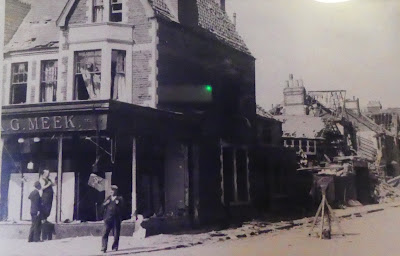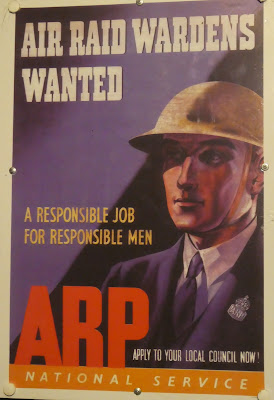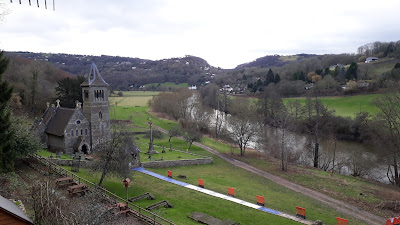I own Cardiff Castle.
OK, strictly speaking it's me and everyone else who lives in the City of
Cardiff. It was left to Cardiff by the Marquis
of Bute. Then someone probably asked 'Why
do I have to pay to get into the castle when I already own it?'. Fair point.
So nowadays all citizens of Cardiff have free access to much of Cardiff
Castle, provided that is they have purchased a Cardiff Key for £5 which is
valid three years. So not strictly free
I guess, and it's not a key either, it's a bit of plastic with your photo on
it. Anyhow, in an effort to go somewhere
in Cardiff Castle we hadn't visited previously we headed for the wartime shelters.
 |
| The Air Raid Shelters in Cardiff Castle |
When the castle was still in the ownership of the Marquis of
Bute he kindly let the citizens of Cardiff take shelter there when the WWII air
raid sirens sounded. Bomb shelters were
traditionally underground but someone pointed out that the castle walls are pretty
thick and anyone hiding in the passageways between the walls were likely to be
fairly well protected. In order for
people to avoid having to enter over the drawbridge route, and I guess have to
pay the entrance fee, they drove holes in the castle walls and constructed
wooden ramps up to the shelters. It was even nicer of the Marquis to allow this
to happen to his beloved castle, but then again he and his workers had already
spent many years knocking it around so a bit more remodelling work wouldn't
make much difference.
 |
| The wooden ramp built into the wall of Cardiff Castle in WWII |
I don't suppose I'm the first person to think that if 1800
people could shelter here in WWII then wouldn't the place be equally good today
to help get Cardiff's homeless off the streets on cold winter nights. The castle passageways were however bitterly
cold and I quickly changed my mind about that being a viable option.
 |
| A wartime kitchen - not keeping up with the washing up. |
The exhibition is somewhat basic. There are some photos of wartime Cardiff, the
damage incurred by the raids and the ARP (air raid precaution) staff involved but
none of it is labelled. Equally frustrating is the ear deafening noise of
aeroplanes, bomb blasts and sirens that museums such as this feel is essential
to emit from loudspeakers dotted around.
No it's not! To me it is sombre
and sad and I would prefer to experience it in peace or if necessary with some appropriate
sombre and sad music playing quietly in the background.
 |
| Bomb damage to one of the streets off Albany Road, Cardiff |
The passage walls are lined with posters of the time
encouraging people not to waste resources, not to gossip as there may be spies
around and to grow your own vegetables. There
is a reproduced Anderson shelter built into the passageway. A couple of days
later when wandering around Newport I passed an Anderson shelter preserved in
someone's back garden. I guess there
aren't many remaining nowadays as most people would have been only too glad to
see them removed when peace came.
 |
| A preserved Anderson shelter in Newport. |
I'm lucky enough to be too young to have lived the war but
recall my mother talking about her childhood here in Cardiff. They used to have an Anderson shelter in the
garden but I also remember her talking about sheltering under the stairs when
the sirens went off. She said that the
theory was that the stairs often survived when a house was bombed so it was the
safest place to be. Maybe that was
before their Anderson shelter arrived.
 |
| Some of those helping to protect Cardiff citizens in WWII |
My grandfather wouldn't have been have been with the rest of
the family in the shelter as he was an ARP warden. His job was to patrol the local area to
ensure people were complying with the blackout restrictions and check for any
light escaping around the blinds. I
guess he was also involved in the aftermath of the raids but he didn't talk to
us about that aspect.
My grandmother was a primary school teacher. Again she didn't talk to us grandchildren
about wartime experiences. I doubt they
wanted to be reminded about it.. My
mother however told me that my grandmother's saddest experience was going into
school when they reopened after the raids and seeing the empty seats of the
children that had been killed.
 |
| Bomb shelter exhibition |
I often tend to forget that Cardiff was a Luftwaffe target. In
Coventry, where I used to live for many years, it seemed to be more often discussed. That's probably because Coventry was very
badly impacted and the shell of the old Coventry Cathedral still stands in the city
centre as a reminder. Llandaff Cathedral
in Cardiff was also hit but subsequently repaired.
 |
| Damage to Llandaff Cathedral |
Some 355 people were killed during the air raids on Cardiff
and 500 seriously injured. Given the
number of properties that were destroyed or damaged it is staggering that the
number is so low. Schools, the infirmary,
ships in the docks and a cinema were hit as well as many houses. Those air raid sirens and shelters must have
done a good job.
 |
| Bomb damage to Albany Road, Cardiff. |
Perhaps the biggest raid of the war on Cardiff was on the night
of January 2nd 1941. It was a clear
moonlit night. First to fall were many incendiary
bombs hitting places including the Castle grounds. Fires around the city lit up the night sky. This
was followed by a rounds of heavy bombs that caused widespread damage. A large bomb fell on the gasworks in
Grangetown. Some 165 people were killed
that night and it took the city sometime to recover. The air raid went on for some ten hours in
total. It must have been a horrifying
experience to live through.
 |
| Newspaper headlines from Jan 3rd 1941 |
The exhibition at Cardiff Castle concentrated mainly of
wartime life, the food shortages and alike.
It's largely geared towards children and serves to teach them about our history. It did motivate me to go away and read up
some more about the raids but mainly made me thankful that at least as far as
our country is concerned it is a largely peaceful era though sadly not for many
in other countries.











